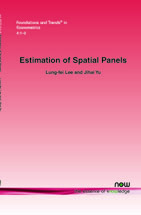Estimation of Spatial Panels
By Lung-fei Lee, Department of Economics, The Ohio State University, USA, lflee@econ.ohio-state.edu | Jihai Yu, Guanghua School of Management, Peking University, China and Department of Economics, University of Kentucky, USA, jihai.yu@gsm.pku.edu.cn
Abstract
Spatial panel models have panel data structures to capture spatial interactions across spatial units and over time. There are static as well as dynamic models. This text provides some recent developments on the specification and estimation of such models. The first part will consider estimation for static models. The second part is devoted to the estimation for spatial dynamic panels, where both stable and unstable dynamic models with fixed effects will be considered.
For the estimation of a spatial panel model with individual fixed effects, in order to avoid the incidental parameter problem due to the presence of many individual fixed effects, a conditional likelihood or partial likelihood approach is desirable. For the model with both fixed individual and time effects with a large and long panel, a conditional likelihood might not exist, but a partial likelihood can be constructed. The partial likelihood approach can be generalized to spatial panel models with fixed effects and a space–time filter. If individual effects are independent of exogenous regressors, one may consider the random effects specification and its estimation. The likelihood function of a random effects model can be decomposed into the product of a partial likelihood function and that of a between equation. The underlying equation for the partial likelihood function can be regarded as a within equation. As a result, the random effects estimate is a pooling of the within and between estimates. A Hausman type specification test can be used for testing the random components specification vs. the fixed effects one. The between equation highlights distinctive specifications on random components in the literature.
For spatial dynamic panels, we focus on the estimation for models with fixed effects, when both the number of spatial units n and the number of time periods T are large. We consider both quasi-maximum likelihood (QML) and generalized method of moments (GMM) estimations. Asymptotic behavior of the estimators depends on the ratio of T relative to n. For the stable case, when n is asymptotically proportional to T, the QML estimator is $\sqrt{nT}$-consistent and asymptotically normal, but its limiting distribution is not properly centered. When n is large relative to T, the QML estimator is T-consistent and has a degenerate limiting distribution. Bias correction for the estimator is possible. When T grows faster than n1/3, the bias corrected estimator yields a centered confidence interval. The n and T ratio requirement can be relaxed if individual effects are first eliminated by differencing and the resulting equation is then estimated by the GMM, where exogenous and predetermined variables can be used as instruments. We consider the use of linear and quadratic moment conditions, where the latter is specific for spatial dependence. A finite number of moment conditions with some optimum properties can be constructed. An alternative approach is to use separate moment conditions for each period, which gives rise to many moments estimation.
The remaining text considers estimation of spatial dynamic models with the presence of unit roots. The QML estimate of the dynamic coefficient is $\sqrt{nT^{3}}$-consistent and estimates of all other parameters are $\sqrt{nT}$-consistent, and all of them are asymptotically normal. There are cases that unit roots are generated by combined temporal and spatial correlations, and outcomes of spatial units are cointegrated. The asymptotics of the QML estimator under this spatial cointegration case can be analyzed by reparameterization. In the last part, we propose a data transformation resulting in a unified estimation approach, which can be applied to models regardless of whether the model is stable or not. A bias correction procedure is also available.
The estimation methods are illustrated with two relevant empirical studies, one on regional growth and the other on market integration.
Estimation of Spatial Panels
Spatial panel models have panel data structures to capture spatial interactions across spatial units and over time. There are static as well as dynamic models. Estimation of Spatial Panels provides some recent developments on the specification and estimation of such models. The first part considers estimation for static models. The second part is devoted to the estimation for spatial dynamic panels, where both stable and unstable dynamic models with fixed effects will be considered. The estimation methods are illustrated with two relevant empirical studies, one on regional growth and the other on market integration.
